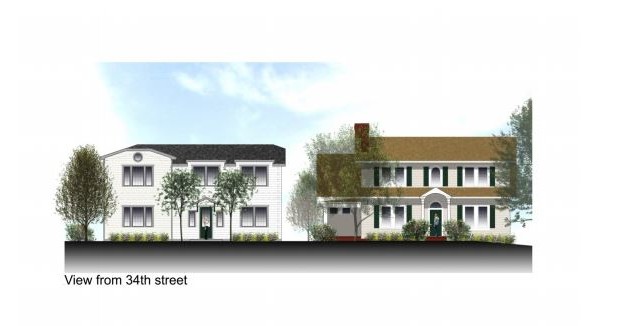Steck House at center of project, now BoA case
Tuesday, January 26, 2016 by
Elizabeth Pagano The city’s Board of Adjustment is taking a little more time to consider whether a North University site plan was approved in error.
Appellant Leon Barish has asked the board to weigh in on how staff applied the compatibility setback for a project surrounding the historic Steck House during the site-plan approval process. Barish told the board that his case was about enforcing the North University NCCD (Neighborhood Conservation Combining District) agreement “in the face of what we believe is an improper and erroneous staff interpretation.”
However, board members were unable to come up with the seven votes necessary to reverse staff’s decision, or uphold it. Instead, they opted to postpone the decision until their February meeting.
At the heart of the issue is the development proposed to surround the Steck House at 305 E. 34th St., which was zoned historic is 2004. Currently, developers plan to rehabilitate the main house and add three multifamily buildings to the property. Barish explained that the multifamily buildings are slated to be built within the 25-foot compatibility setback of a neighboring house at 309 E. 34th St., which has multifamily zoning but is, in fact, a single-family home.
Staff maintains that building within the 25-foot setback is allowed because of the Steck House’s historic zoning. Under city code, historic properties are exempt from compatibility setbacks.
Barish argued that the NCCD supersedes the Land Development Code when the two are in conflict. Although he may be correct, his argument rests on a portion of the NCCD that isn’t explicitly laid out. While the neighborhood document specifically dismisses the rear compatibility standards on the property, it does not address the front compatibility standards. Barish believes the implication is that those front standards do still apply under the NCCD.
To bolster his case, Barish furnished the opinion of former Historic Landmark Commission Chair Laurie Limbacher. She explained, in an affidavit, that the purpose of the exemption from compatibility was not intended to make it easier to add nonhistoric additions or structures to a historic property but rather to make it easier to restore historic properties that may not comply with setbacks.
Barish also made the point that it was not the property of the Steck House that was historic, just the house itself, and the exemption from the compatibility standards should not apply to the new multifamily buildings.
Lynda Courtney, who supervised the site-plan review process for the city, told the board that all of the issues being raised in the interpretation had already been considered. She pointed out that the property was zoned historic in June 2004 and that the NCCD was put in place in August 2004. She said that, without an explicit statement in the NCCD saying otherwise, compatibility wasn’t required on the property.
Developer Cater Joseph has been working on the Steck House Apartments for the past two years, in accordance with his understanding of the neighborhood regulations. He said he had already invested a great deal of time and money in the plans and had gone through them with the understanding that the interpretation provided by city legal would stick.
Joseph explained that the same debate had surfaced during the site-plan review process and that “a considerable amount of time was spent stewing on it,” leading ultimately to the interpretation being questioned that night. He said it was clear that, under city code, compatibility standards did not apply to the property. He said that if the neighborhood wished it to be otherwise, it should have been specifically addressed through the NCCD, as is the case in the Castle Hill Local Historic District preservation plan.
“I do not understand why me following the rules they set in place is not acceptable to them,” said Joseph.
Though there was a clear division on the dais, Chair William Burkhardt, for one, expressed strong opposition to staff’s interpretation.
“It’s clear what the intent is, and at least a flag should have been raised before a decision was issued. The NCCD was very clear and very specific. … The intent is very obvious to me, and it should never have been granted,” said Burkhardt.
Board Member Don Leighton-Burwell noted that the project could not be carried out if the property was not zoned historic and was, instead, a new development.
“This is just one of those cases where the letter of the law and the intent have gotten disconnected in some sort of ‘News of the Weird’ sort of way that would allow something that was clearly not the intention of the code,” said Leighton-Burwell.
Board Member Melissa Neslund agreed with that concept, but it led her to a different conclusion.
“We have such a complex code, with so many layers. I feel for the staff every day, trying to make these determinations and interpretations,” said Neslund. “I personally have to uphold staff’s position.”
Initially, Barish was also asking for an interpretation about the parking for the project. He claimed that the required parking was calculated incorrectly, because some of the rooms that were not identified as bedrooms were, in fact, bedrooms. However, Joseph had revised his plans since those calculations had been made, so Barish withdrew that request for interpretation.
Prior to the board’s decision to postpone the case, a vote to uphold staff’s interpretation failed in a vote of 5-4, with Burkhardt and Board members Leighton-Burwell, Melissa Hawthorne and Brooke Bailey voting in opposition.
Rendering of the Steck House Apartments project courtesy of the city of Austin.
You're a community leader
And we’re honored you look to us for serious, in-depth news. You know a strong community needs local and dedicated watchdog reporting. We’re here for you and that won’t change. Now will you take the powerful next step and support our nonprofit news organization?






